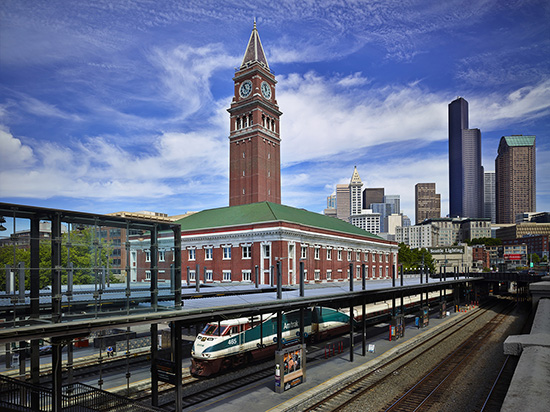|
Subscribe / Renew |
|
|
Contact Us |
|
| ► Subscribe to our Free Weekly Newsletter | |
| home | Welcome, sign in or click here to subscribe. | login |
Construction
| |
 |
January 26, 2015
Structural systems
National finalist: Gold award
Hart Crowser
Project: King Street Station Restoration
Client: ZGF Architects
King Street Station is an iconic building, designed by the same firm that designed New York’s Grand Central Station. Originally built in 1906, King Street Station is one of the most recognizable buildings in Seattle.
But there was a problem. Its landmark 245-foot-tall clock tower had already been damaged by an earthquake and would not survive another major shakeup. The seismic design loads and poor condition of the structure required adding 1,345 tons of steel within the existing structure.
Hart Crowser used state-of-the-art seismic design and also took helical pile technology to another level in engineering practice, making the project feasible at this constrained site.
Much has changed since 1906, such as the need for sustainability. The requirement of a LEED silver certificate was surpassed by the design, and the building achieved LEED platinum certification.
Hart Crowser recommended the use of geothermal heating and cooling. This was one of the first projects in downtown Seattle to install a geothermal well field and heat pumps to reduce the building’s energy consumption.
Hart Crowser also performed geophysical testing to “see” through the ground and identify the toe of the existing timber piles supporting King Street Station. This eliminated the need for expensive and disruptive ground improvement that was recommended by a previous geotechnical consultant. This alone saved the city of Seattle half a million dollars.
Using state-of-the-art-seismic modeling, innovative geotechnical engineering design and geophysical investigation in a unique combination, Hart Crowser helped the Seattle Department of Transportation make this iconic building safe in a sustainable manner, while saving over $750,000 in public money.
Other Stories:
- National finalist: Platinum award
Magnusson Klemencic Associates - Complexity
Best in State: Gold award
Parametrix - Social/economic sustainability
Best in State: Gold award
Hart Crowser - Future value to engineering profession
Best in State: Gold award
Herrera Environmental - Future value to engineering profession
Best in State: Gold award
David Evans and Associates - Originality/innovation
Best in State: Gold award
Tetra Tech - Transportation
National finalist: Gold award
Jacobs/GeoEngineers - Structural systems
National finalist: Gold award
CKC Structural Engineers - Structural systems
National finalist: Gold award
HNTB Corp. - Structural systems
National finalist: Gold award
Buckland & Taylor - Exceeds owner/client needs
Best in State: Gold award
Hart Crowser



